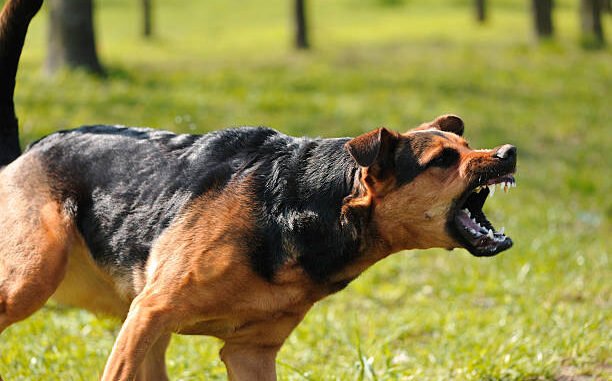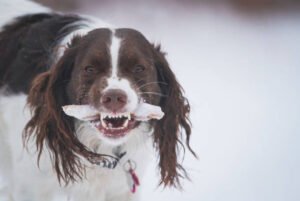
It is common for most puppies to bite, but it’s your responsibility as a dog owner to stop this behaviour as soon as possible. If you don’t stop this as quickly as possible, your puppy’s growls, snaps, or bites regularly might become aggressive when your dog is grown. Aggression in dogs is one of the main reasons dog owners seek help from a professional dog trainer or animal behaviourist.
Warning: Not only large and scary dogs or so-called “dangerous breeds” are prone to aggression; any dog breed, big or small, is capable of becoming aggressive, even the smallest of them, the chihuahua.
However, aggressive dog behaviours can’t be cured overnight. Let’s share some steps you can take to curb your dog’s aggressive behaviour and help him remain calm.
Why Do Dogs Behave Aggressively?
Aggressive behaviour in a dog refers to any trait connected with an attack or any behaviour that gives signs a dog may likely attack. The traits an aggressive dog is likely to attack include becoming still and rigid, growling, snarling, baring teeth, lunging, and nipping or biting.
Signs That Your Dog Might Become Aggressive
Although some dogs may not tend to be aggressive later in the future, still keep in mind that any dog can pick up aggressive behaviour, and it’s important to track warning signs, like:
- Growling and snapping
- Raised fur
- A rigid body and quickly wagging tail
- Lip licking or yawning
- Averting gaze
- Cowering and tail-tucking
- Seeing the whites of the eyes
Note: Not all dogs exhibiting this behaviour are generally aggressive—many warning signs also indicate anxiety or fear.
Check out Thesprucepets for: Why Dogs get Aggressive

Steps To Stop Aggression
Identifying The Cause
To find solutions to any problem, it is important to know the cause and find possible solutions. For dogs, the first step toward stopping their aggression is to find out what is causing it. For instance, some dogs growl as strangers, or their owners approach them while eating or chewing a bone.
Dogs’ aggressive behaviour is not limited to humans. Some dogs may be calm toward humans and become aggressive around other animals, only specific animals (cats but not other dogs), or toward inanimate objects, such as vehicles, other moving objects, or yard equipment.
So now you see that finding the cause of your dog’s aggression is key, as you can’t devise a plan to mend your dog’s behaviour until you know the reason behind it. Let’s walk you through the most common types of dog aggression:
- Territorial aggression: Dogs may display aggressive behaviours to protect or defend their space or homes from what they consider a threat or an intruder.
- Protective aggression: This type of aggression is similar to territorial aggression, but the difference is that the dog displays aggression to protect members of its pack against another animal or a person. This type of aggression is common among mother dogs trying to protect their puppies, and they may become hostile toward anyone near them.
- Possessive aggression: As mentioned earlier, dogs display aggression to protect their food, chew toys, bones, or other valuable objects. This is sometimes called recourse guarding.
- Fear aggression: This type of aggression is common among low-esteem dogs or dogs with separation anxiety. A fearful dog exhibits this type of aggression when it tries to retreat in a scary situation but then attacks when cornered and scared.
- Defensive aggression: Similar to fear aggression, a dog might attack to protect itself rather than try to retreat first. These dogs generally give physical signs, such as turning away their heads, that indicate that they want to be left alone before biting.
- Social aggression: This type of aggression is always exhibited by dogs that are not properly socialised with other dogs, people, and their social environment. Due to their low level of socialisation, they tend to attack everything they are unfamiliar with. Some dog owners do this to make their dogs aggressive.
- Redirected aggression: Sometimes, you might wonder why your dog will turn against you when you are trying to stop a dog fight. This is called redirected aggression. A person who tries to break up a dog fight may provoke the dog to become aggressive toward them. It can also happen when the dog can’t reach the target of its hostility, such as when it wants to mate with a dog or meet a neighbouring dog on the other side of a fence.
- Pain-elicited aggression: This is a form of aggression displayed by dogs in pain or injured, as they won’t want you to come close to them.
- Sex-related aggression: This is a form of aggression related to two male dogs or two female dogs when trying for the attention of a mate.
- Predatory Aggression: Predatory aggression is more common in large bearding or livestock dogs that behave aggressively without much warning when exhibiting predatory behaviour. This instinct in dogs may become a serious issue if precautions are not taken, as it can be dangerous when a child is playing chase with the dog, and the dogs with predatory aggression may quickly turn on and possibly attack the innocent child.

Note when your dog becomes aggressive and cause
By doing this, you will easily be able to determine your next step, or your dog training will be able to determine the next step to embark on. It is essential to deal with the underlying cause of the aggression. There are a number of ways you can manage the hostility and help your dog remain calm, although it will take a lot of time, consistency, and possibly the help of a professional.
See Your Veterinarian
Dogs that aren’t normally aggressive but have Pain-elicited aggression might suddenly develop aggressive behaviours. To stop the aggression, the only thing needed is to treat the dog for any underlying medical issues. Health problems that may cause aggression are hypothyroidism, painful injuries, and neurological problems such as memory loss, epilepsy, and brain tumours. Converse with your vet to determine whether this is the case with your dog.
Dog Aggression Training
If the cause of your dog is not related to pain or medical issues, then it is time to contact a professional animal behaviourist or dog trainer because aggression is not just a problem; you shouldn’t attempt to fix it on your own. A professional can help you determine what’s causing your dog’s aggression and create a correction plan to calm your dog.
Create a Plan
As said earlier, an animal behaviourist or dog trainer can help you determine the best approach for correcting your dog’s aggression. In most cases, you’ll use positive reinforcement techniques to teach your dog new behaviours, as it is the best and most common way of training.
For example, if your dog is usually aggressive toward strangers, you can start by standing far away from someone your dog doesn’t know. It would help if you always lead when walking with your dog and don’t let it walk ahead of you. Then, reward with treats as you gradually decrease the distance between your dog and the stranger. Later on, you’ll see a reduction in its aggression.
Avoid Punishment
Punishing or hitting your dog for exhibiting aggressive behaviour is a bad idea. It can backfire and increase the dog’s aggression level. If you respond to a growling dog by hitting, yelling, or using other aversive methods, the dog may think that you are trying to challenge it and then feel the need to defend itself by attacking you.
Punishing your dog for aggressive behaviour may also lead to your dog biting someone else without giving any sign or warning. For instance, a dog that growls at children is letting you know that he is uncomfortable around them. If you punish a dog for growling, he might not give you a warning the next time he gets uncomfortable with the children but may simply bite without warning before the incident.
Leave a Reply